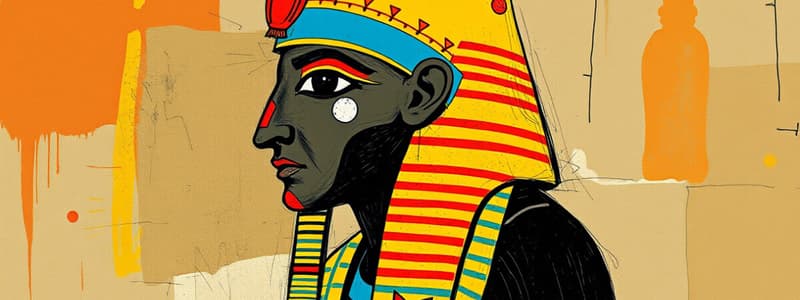Podcast
Questions and Answers
What is the historical context of the Palette of King Narmer?
What is the historical context of the Palette of King Narmer?
This piece portrays the unification of upper and lower Egypt during the end of the Predynastic period ruled under the first dynasty of King Narmer and tells the story of Narmer's conquest of Lower Egypt.
What was the Palette of King Narmer used for?
What was the Palette of King Narmer used for?
It was used to prepare eye makeup, which Egyptians applied to protect their eyes from the sun's glare.
Why is the Palette of King Narmer so important and significant?
Why is the Palette of King Narmer so important and significant?
It marks the transition from prehistorical to historical period in ancient Egypt and sets the standard for the depiction of human figures in art.
Who are the two heads at the top of each side of the Palette identified as?
Who are the two heads at the top of each side of the Palette identified as?
What does Hathor represent?
What does Hathor represent?
What is depicted between the heads on the Palette?
What is depicted between the heads on the Palette?
What is shown on the back of the Palette?
What is shown on the back of the Palette?
What does the slaying motif symbolize?
What does the slaying motif symbolize?
What do the elongated necks of the two felines on the front of the Palette form?
What do the elongated necks of the two felines on the front of the Palette form?
What is the significance of the falcon king capturing the human-headed hieroglyph?
What is the significance of the falcon king capturing the human-headed hieroglyph?
What is located below the king on the back of the Palette?
What is located below the king on the back of the Palette?
What do the intertwined necks of the animals symbolize?
What do the intertwined necks of the animals symbolize?
What does the great bull on the front Palette symbolize?
What does the great bull on the front Palette symbolize?
How does Egyptian art portray Narmer?
How does Egyptian art portray Narmer?
What became the standard in Egyptian art?
What became the standard in Egyptian art?
In Narmer's Palette, the sculpture subdivided the surface into _______ and inserted _______________
In Narmer's Palette, the sculpture subdivided the surface into _______ and inserted _______________
What do the horizontal lines in the Palette define?
What do the horizontal lines in the Palette define?
What compositional scheme was established by the Palette of King Narmer?
What compositional scheme was established by the Palette of King Narmer?
Flashcards are hidden until you start studying
Study Notes
Historical Context
- Depicts the unification of Upper and Lower Egypt at the end of the Predynastic period.
- Represents King Narmer's conquest of Lower Egypt, marking a significant transition in Egyptian history.
Functionality
- Originally used to prepare eye makeup, protecting against the sun's glare.
Significance
- Marks the transition from prehistoric to historical periods in ancient Egypt.
- Establishes a blueprint for figure representation influential in Egyptian art.
- Earliest known example combining images and hieroglyphics to narrate Narmer's conquests.
Artistic Elements
- Features two cow heads with a woman's face, typically identified as Goddess Hathor, symbolizing motherhood and kingship.
- Incorporates hieroglyphs framing Narmer's name, emphasizing royal legitimacy.
Iconography
- The back showcases Narmer wearing the white crown of Upper Egypt, slaying a captured enemy, embodying the living Horus or falcon king.
- Symbolizes Narmer's power over Lower Egypt through the depiction of a falcon capturing a human-headed hieroglyph, representing the land.
Themes and Motifs
- The slaying motif illustrates the triumph of Egyptian deities and kings over adversaries.
- The intertwined necks of two felines reflect the unification of the two kingdoms.
- The great bull symbolizes Narmer's strength, indicating dominance over rebellious cities.
Artistic Representation
- Narmer is depicted in a composite style: profile views for head, legs, and arms with frontal views for eyes and torso, an enduring characteristic of Egyptian art.
- The palette's surface is divided into registers, aligning with artistic norms in Mesopotamia.
Structural Design
- Horizontal lines separate narratives, defining the ground beneath figures, a common theme also seen in Mesopotamian art.
- The compositional scheme established by the palette influenced Egyptian art for millennia.
Studying That Suits You
Use AI to generate personalized quizzes and flashcards to suit your learning preferences.




